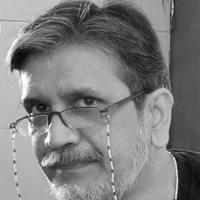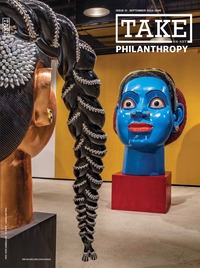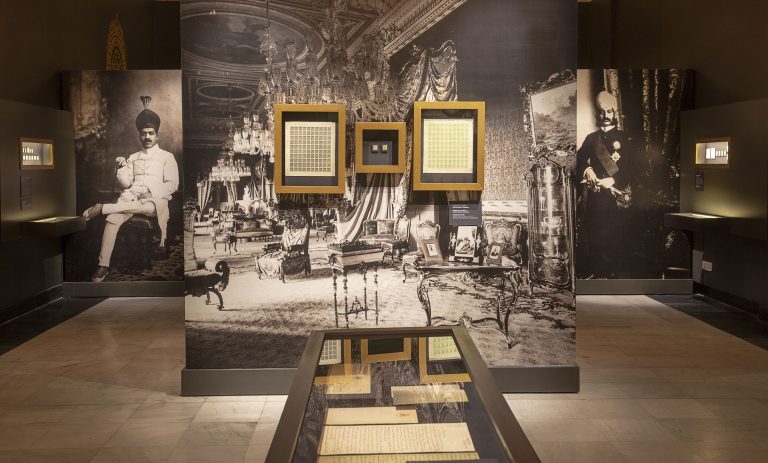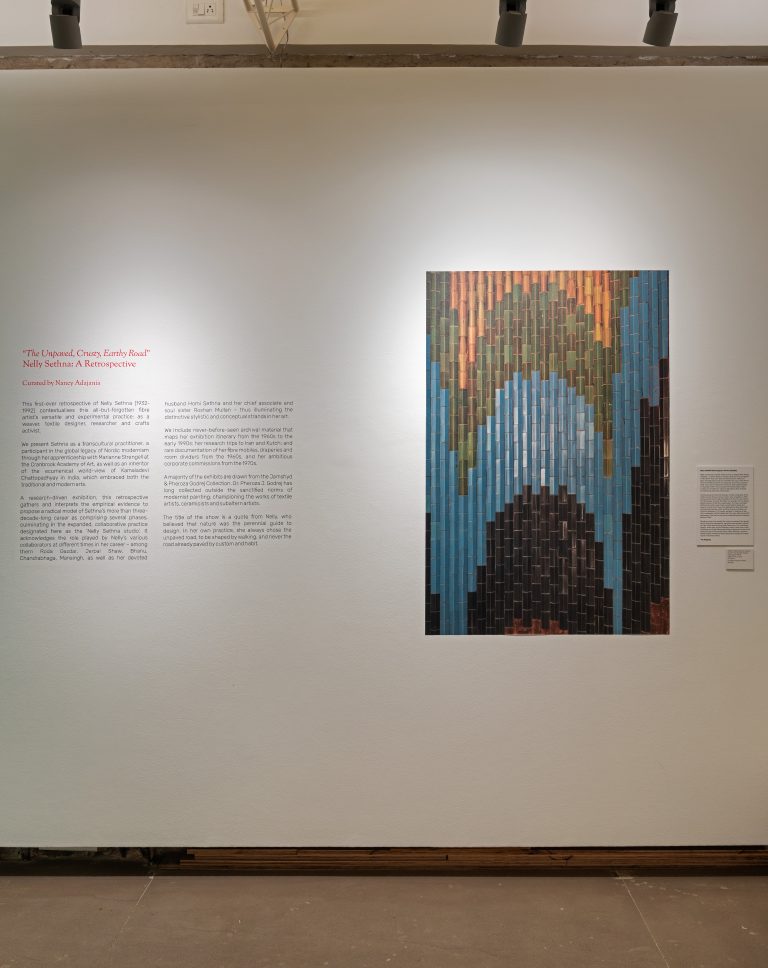Painter, printmaker, photographer and teacher Jyotindra Manshankar Bhatt, much known as Jyoti Bhatt completed his 84th year on 12th March 2018. A comprehensive show of his works was long overdue in Baroda, where he has worked for over six decades. Finally the mini-retrospective of his works at Gallery Ark brought together a selection of his oeuvre for the delectation of the audience in his city.

Jyoti Bhatt was associated with the Faculty of Fine Arts of the M.S. University of Baroda from its inception. He joined as a student in 1950 and after completing his studies, he was absorbed as a teacher in his alma mater, where he served till his retirement in 1992. Along with his wife, ceramic artist Jyotsna Bhatt, he continues to live and work in Baroda.
Jyoti Bhatt’s journey began in the post Independent milieu where Indian artists were eager to actively interact with the world and at the same time seek to engage with the local in search of a national identity. The eclectic environment of Baroda with its pedagogical openness and the spirit of experimentation proved to be electrifying for this gifted artist, who already came equipped with some exposure to art and alternative educational practices.

It will be pertinent to mention that his childhood years were spent amidst the exciting cultural environment of his native Bhavnagar, a town noted for its cultural sophistication that saw educational experimentation pioneered by Gijubhai Badheka and also Jyoti Bhatt’s father Manshankar Bhatt, an educationist and a nationalist. Being a Gharshala (Home School) student, he was closely linked with Tagore’s Santiniketan experiment with alternative education, Gandhiji’s Gujarat Vidyapith and Gijubhai’s own ideas about open schooling. It was here that he was fiest exposed to the works of Ravishankar Raval, Somalal Shah and Jagubhai Shahand by extension to the Santinikatan masters like Nandalal Bose, Benode Behari Mukherjee and Ramkinkar Baij along with N.S. Bendre through pioneering magazines such as Kumar. In a very early work titled Cheta R’ejo Maa Baap (Please keep distance Sir) depicting an everyday experience his critical awareness about society was ecident. It showed a competently drawn figure of a Harijan (Dalit) carrying human waste on his head going door-to-door yelling the warning so as to avoid accidentally polluting the upper caste clientele. Admittedly a rather unusual subject for a 12-year-old-boy! Unexceptionally, like many of his peers in Baroda, as well as elsewhere, his early works seem heavily indebted to a post-Cubist language, the lingua franca of international Modernism at the middle of the last Century. The lamp series from the late 1950s apart from being a romantic image with its association with waiting nayikas in Indian literature also acknowledges a debt to his mentor K.G. Subramanyan, who had also used the motif quite extensively. The consummate drawing skills that Jyoti Bhatt always had also led him to experiment with a stylized figuration that doff its hat at an earlier tradition that permeated from Bengal school via his early mentors such as Somalal Shah and obviously encouraged by Bendre. His works produced while he was a student Krishna Leela, won him the President’s gold medal and the Rabari Couple from 1957, stand witness to the strand of his early works.
His one-year stint at the Accademia di Belle Arti di Napoli on Italian Government Scholarship (1961-62) and subsequent study of printmaking at Pratt Institute and Pratt Graphic Art Center, New York (1964-66) on Fulbright Scholarship & JD Rockefeller III Fund fellowship opened the horizon of possibilities of using other forms of image making such as graphics, collage and mixed-media works.

The significant works from this phase such as the Shimmering Landscape (1964), an embossed print on copper sheet or its later intaglio variation from 1968, convey a great graphic possibility of conflating the map of Manhattan or a view from atop a towering skyscraper with a suggestion of teeming multitudes in a space that remains emphatically two-dimensional. Unfortunately these were not part of the show. This was a pity, because the abstraction inherent in them with their marks of dots and lines reappear years later in works seemingly more decorative but no less convincing. The flatness of space in Jyoti Bhatt’s work, much like his cross-referencing in content that traverses time and cultures, owe as much debt to the then-current international trend as to the folk art and design traditions of India. Similar dots reappear in the late phase quite extensively both in painting and in prints. Binduleela, an intaglio print made in 2013 is a case in point. It has as much to do with body decoration of Rathwa tribals during the Holi festivities or Gond tribal painting as with the early experimentation in pure abstraction in New York. This conflation of a variety of inputs, seemingly effortless eclecticism can be traced back to the ambient pedagogical structure of Baroda that was shaped by Sankho Chaudhuri, K.G. Subramanyan, N.S. Bendre, Markand Bhatt, V.R. Amberkar among others. It suited Jyoti Bhatt very well as it resonated with his own predilections.
One of the underlying preoccupations that one witnesses time and again in Jyoti Bhatt’s carefully built syntax is of cross-referencing and eclectic synthesis where street graffiti, pop icons, found images, texts meet with classical imagery, art historical allusions can be seen in a non-hierarchical flat space. He was rooted in his cultural moorings and at the same time teased out layered meanings and readings of not only the imagery but also of the freely used texts and words that often accompany the visuals. The etching print titled Self Portrait from 1969 can be a case in point, where the imagery is replete with all the markers of a modernist search for Indian symbolism; the head of the anthropomorphic form is a mangalghat (auspicious pitcher) complete with foliage, coconut and the two all-seeing eyes on either side; scattered all over the picture plane are shapes reminding one of tantric yantras and mandalas, paduka (footprint) signs along with a sprinkling of his favourite motifs of a scorpion, parrot, Om, Shri and so forth. The Hindi and English bilingual text similarly mentions the sun, the moon, the sky (gagan and nabh), the lotus (kamal), traveller (pathik), the spirit (atma), nirvana etc. But the Gujarati inscription on the top and the top left sets the tone of mocking self-referencing. It proclaims, “Where did this peacock come to this mortal world?” and “oh, peacock, where did you get such captivating beauty?” The bold English font that runs vertically from top to bottom on the left states rather blandly “This is pseudo tantric modern Indian Art”. It is this self-deprecating humour questioning grand standing and declamation that sets him apart. Infallibility is not for him. Jyoti Bhatt both as a human being as well as an artist never winced from turning his gaze on what he considered follies with equanimity and élan.
His rootedness and deep knowledge of Indian art, tradition and lore are countered in equal measure with his irony and sardonic humour that does not preclude turning the critical gaze on himself and laughing at his own fallibilities. Those who are privy to his narration of how enamoured he was with his discovery of the white glue in Italy would vouch for his capacity to laugh at himself. On his return, he brought back quite a load of it with him, only to find the now-ubiquitous synthetic resin based Fevicol being introduced in the Indian market about the same time, making all his pains go waste.

A cursory look at the usage of visuals and text in a pastiche- like manner in a number of works, both prints and paintings, reveal that behind the all too familiar tropes that lull one into a decorative veneer, lurks a sharp critical mind. A digital print from 2003, titled Phoenix, establishes the importance of this recurring theme of the self-perception of the artist. Here in a sort of a recap of his oeuvre, the references range from his oft-used imagery of nayika with parrot, the pundit, the maze- like yantra, a rangoli motif, a swastika, pop images from match boxes, prints, the heart sign, a chameleon with Gandhi cap (the marker of the politicians so lampooned by artists and cartoonists) to Picasso’s Guernica and The Grand nude by Matisse. The text uses loaded words like ‘descent’, ‘decadence’, ‘ascent’, ‘resurrection’, and quotes from Guru Nanak and Kabir. Add to that truck signs like buri nazar wale (a familiar truck signage in North India to ward off the evil eye) along with an iconic image of a four-armed man with a paint brush marked ‘Hnu’ (I or Me in Guajarati), the potpourri is complete. There are two clocks; one is marked behind the time’ and the other ‘ahead of time’, both showing the same time – 12:15, a visual manifestation of the Indian expression ‘barabajjaanaa’ (literally meaning – the clock has struck 12 but implies something is wrong beyond repaire). At the top left next to the big red Shri written in Devanagari is a statement in English – ‘pseudo Indian painting’!
The exhibition attempted to showcase a wide variety of mediums that the artist has worked in and had a fair selection of paintings, reverse paintings, prints in traditional as well as digital media, photographs and some digitally reworked prints of paintings that he preferred to call Digital Reincarnations. These are large digital-prints of works never shown in Baroda and now scattered in private collections. The technical mastery and the child-like enthusiasm with which the artist grapples with both traditional and newer media leaves one quite stumped by the sheer range and quality. The fact that he often eschews traditional painting media and embraces the ‘lesser forms’ like etching, serigraphy, collage, digital print and explore their graphic possibilities have contributed to some extent to Jyoti Bhatt’s relatively lower profile as primarily a printmaker, a sad reflection on our immature art world and privileging certain media over others.
Jyoti Bhatt took to photography in order to after being encouraged by his teacher K.G. Subramanyan, to document traditional crafts of Gujarat. It started with a camera he borrowed from a friend. The habit he picked up early on stayed with him to make him one of the greatest documentary photographers of India. Apart from the folk arts and crafts that he documented across the length and breadth of the country, he was also an intrepid documenter of his time and his milieu. Thanks to him, we have quite an archive of artistic life in Baroda from the sixties onwards. I saw him with a camera even last year in the Faculty Degree show shooting in the notorious mid-day heat of early May with temperatures soaring to 45 degree Celsius!
His documentary photography most often crosses the boundary to become great photographs in themselves. It is very difficult to box his photographs into neat categories. A documentation of a traditional painting on a village hut doubles up as a great portrait, a view of a village fair in Tarnetar easily becomes a landscape and so on. Moreover, there exist a sizeable number that deals with photography as a pure art form not to speak about how it overlaps and often reinvents itself in his graphic prints. There was a small selection from this whole range in the show.
Looking at the panoramic view of the tribal lady walking in front of a vast painted wall (Untitled, Odisha, 1996) that seem to depict a whole universe replete with flora and fauna is a moving experience. One is acutely aware of the epic scale of the tragedy of witnessing a magnificent world that is lost forever. The framing of the Election graffiti (1983) highlights the graphic power of the hand-painted stratified imagery in three rows. It is very close in sensibility to Jyoti Bhatt’s works in printmaking. The reflection of a louvered window with its horizontal bands of light on the glass framed serigraphy of the artist’s iconic head (1974-75) is a study very close to a graphic print.
My personal favourite is the one titled On the road shot in 1969. It was shot in expired coloured film and converted to black and white with hiked contrast resulting in the grainy look. It was also turned into a serigraphic print later. In this photograph, there is a naked child walking with his back to the viewer, silhouetted against a lighter toned road leading all the way to the horizon. The pillared culvert halfway up the road does lend an alternative punctum, the road turns into a deity with two raised arms that lends the image a mysterious power in its desolation.
The Self-Portrait (1977) is a playful image of a head-shaped tear in linoleum flooring with a strategically placed pair of glasses to make it look like a human head. The illusion is so complete despite the obvious artifice that it catches one unaware and induces the pleasurable surprise afresh every time one looks at the image.
One cannot help the bitter irony while looking at the photogravure print, A Tricoloured Portrait, first conceived in 1977 and reworked in 2017, uses a portrait photo of M.F. Husain along with three images of his work. The so-called Bharatmata, which would go on to become so controversial in the hands of regressive politics two decades later – being the central image. The work is awash with the three colours of the national flag in a celebratory euphoria. The irony of how far our national discourse has travelled from the days when it was conceived is unavoidable.
My only gripe with the show is, given the diversity of Jyoti Bhatt’s oeuvre, it could have been conceived on a grander scale, with a little more curatorial consideration such as grouping and contextualising of the works. Having said that, I must congratulate Gallery Ark for bringing a considerable selection of works of this self-effacing titan together. It speaks volumes about the range of the artist that despite the 140 works on display one left wanting more.














